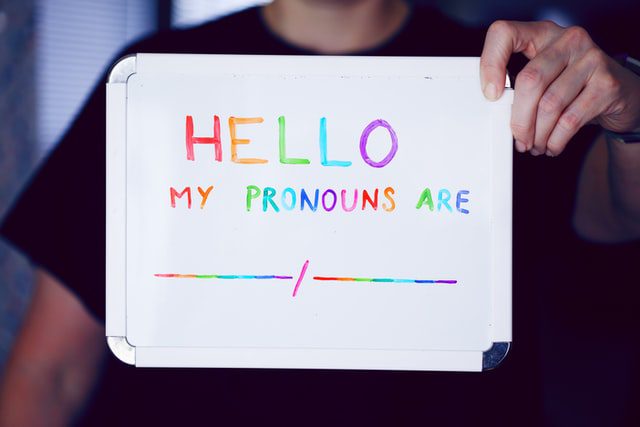
Transgender Etiquette Training
Gender identity is such a personal topic and people may sometimes find it hard to choose the correct words when conversing with transgender people. This is not for lack of respect or admiration, but rather just lack of the appropriate education.
When it comes to gender identity and sexual orientation, there are many different terms to consider. Here are some guidelines to aid in understanding the transgender community a bit better as a non-transgender person.

1. Appearance Isn’t Always Truthful
It isn’t possible to definitively recognize a trans person in a group. Transgender people don’t always visibly appear trans. It is always safe to assume that there are multiple trans people present in a room.
2. Which Pronoun Should I Use?
Pronouns vary widely from person to person and such matters can be sensitive. When you are not clear on which pronouns a transgender person uses, first listen to the pronouns those around them use to describe them.
If you make a mistake and use the wrong pronoun, don’t panic! Simply apologize quickly and don’t make a bigger deal of it than it is. Many transgender people are very understanding of the confusion surrounding such matters, and they are more than happy to help.
If you want to be sure right from the start, it is a good idea to state your pronouns and ask them to do the same.
3. A Transgender Person’s Sexual Orientation
It is crucial to understand the difference between gender identity and sexual orientation. Gender identity refers to our own personal sense of identifying as binary (male or female) or non-binary.
Sexual orientation is quite simply who we are attracted to sexually. Do not assume you know these details about a transgender person. It can be anything from straight, bisexual, gay, to lesbian.
4. Coming Out As A Transgender Person
When people think of gay, lesbian, or bisexual individuals coming out, it is generally seen as a truth that will set them free and allow them to be themselves in an honest and transparent way.
The «coming out» aspect is a bit different for transgender people. Their transition allows them to freely express themselves and develop confidence in their gender identity. Transgender people have no obligation to disclose that they are trans or openly discuss their identity label.
Insisting on having such a discussion will probably make them really uncomfortable. As a nontransgender person, nobody is demanding information about your biological sex so I think we can extend transgender people the same courtesy.

5. Confidentiality
The gender history of a transgender person is extremely personal and it is important to respect the extent to which they are willing to open up. You can never make that decision for them by disclosing information to others. Steer clear of speculation and gossip about transgender people.
Not only is this simply good manners, but you may not realize the weight of the consequences that such speculations may have in terms of discrimination.
If some rare situation arises where disclosure might be beneficial, be sure to ask a transgender person’s explicit permission before saying anything.
6. Respect Their Use of Terminology
Allowing people to discover which identity label fits them best will display the respect you have for their individuality.
Terms such as genderqueer, transsexual, cross-dresser, or non-binary may be explored in their search for their true identity, but they should have the freedom to evaluate their experiences and decide on a term by themselves.
7. Respect A Transgender Person’s Statement
There are so many ways of transitioning of which none are right or wrong per se, they are simply different.
Some transgender people have access to medical care which includes hormones and surgeries, whereas others may not. Some transgender people may even decide that they want to authenticate their gender identity without the use of medical procedures.
Gender identity does not depend solely on physical aspects.
Do not question that a person is transgender if they have explicitly stated that they are. Respect their identity and allow them to live their life as they please.

DOS AND DON’TS
DON’TS
DON’T Use Backhanded Compliments
We sometimes say things that we mean as a compliment, not realizing that it sound incredibly insulting from a transgender person’s perspective.
A common example is when people say something like, «I’d go out with him even if he’s transgender.»
Reading it aloud kind of opens your eyes, doesn’t it?
Another prevalent statement is to say that a transgender person looks like a «real woman» or a «real man». This bluntly implies that a transgender woman is not a real woman or a transgender man is not a real man.
DON’T ask about a transgender person’s genitals, sex life, or surgical status
Think about it. Do you as a non-transgender person ever get asked questions about the appearance of your genitals or about the ways you have sex? I would hope not!
This social etiquette does not change when it comes to transgender people. Do not pry and ask whether they are post-op or pre-op or just anything related to the way they choose to transition.
It is not respectful and such topics should be avoided unless the person very clearly discusses them.
DON’T Ask About Their Birth Name
Transitioning turns a trans person into the very best version of themselves. Many feel relieved to leave their old life and background behind them. Asking them what their birth name is might bring up some painful memories.
Respect their identity by always using their current name.
The principle can be applied to any matters concerning their lives before they transitioned. Some good advice would be to never share birth names or pictures from before the transition.
DOS
Respect And Support All-gender Bathrooms
Many transgender people do not identify with the signs on bathrooms doors.
You can influence this dilemma by encouraging companies and schools to have unisex and all-gender restrooms, making non-gender and transgender individuals feel comfortable using any restroom they please.
Challenge Jokes And Remarks That Are Anti-Transgender
It is surprising to find how common it is for members of the LGB community to make jokes that are insulting to transgender people.
For some reason, they believe that because they are part of the LGB community, they have immunity and are allowed to disrespect transgender people in a comical way.
More common than this are cisgender people displaying hate and discrimination against transgender people and the LGBTQA+ community in general. This will never change if everybody just sits idly by and lets it happen. Make a stand and put them in their place.
When you pick up on this, challenge it! Make it clear that it is completely inappropriate and that they should reevaluate the consequences of their words.
The biggest changes come from the smallest groups. Although it may sometimes seem like homophobia and discrimination are a losing battle, don’t lose faith. This is a battle worth fighting.
Learn About Transgender People
Although the transgender community has only recently received the support and attention it deserves, being transgender is definitely not a new thing.
It has been around since virtually the beginning of mankind, the extensive media coverage is the only thing that has changed.
The best way to respect Transgender people is by learning more about their experiences. Luckily, in this day and age information is easy to find. Listen to podcasts, read books and watch videos and films to better educate yourself.
Make Every Aspect Of Your Work And Life Trans-inclusive
The term «LGBTQ» is more commonly known and recognized than ever before. If a company or group claims to be trans-inclusive, they should be sure to do their research and truly grasp and understand the requirements that come with being trans-inclusive.
A good guideline to follow in the workplace is to refer to people based on articles of clothing instead of gender. For example, referring to someone as «the person with the green dress» is better than saying «the woman in the dress».
Terms like «madam» and «sir» should also be avoided.
We may think that having everyone introduce their pronouns is a smart idea, and I’m not saying that it is not, but it may make transgender people feel like they’re being put on the spot. It isn’t a light topic for them like it is for most cis-gendered people, and that needs to be respected.




